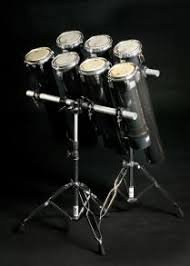Re: Resistance and capacitance across pedals
10 true bypass in a row? I assume you have some of those on all of the time If not, I'd be weary of that many before even measuring though -As remember -True bypass pedals force the signal to transition through a minimum of 11 different metal conductor mediums before coming out the other side -all with different impedance, capacitance characteristics etc It doesn't just look like a single cable -electrically speaking -as some people often compare -it is inferior at some point (no telling where that point is to your ears though) -but that inferior electrical path does add up when you have a bunch of TB pedals serialized.
So for a sec let's forget calculating impedance, capacitance etc through the entire chain and just look at the physical layer of the argument for giggles -Even if this doesn't really apply exactly to you directly OP and is ultimately an abstraction for the forum to foster discussion
So think of it like this -for every pedal you add in true bypass mode your signal must pull electrons on and off the flowing differing materials -And for consumer metal to metal connections most devices are using Solder as the intermediate connection -as expensive Wire Wrap and Crimp and Solder or Punch or punch then solder (true conductor to conductor connections) are not used in pedals so there is always solder in between components and wires.
PATH OF ONE "SWITCHED OFF" TRUE BYPASS PEDAL (Multiply this by 10x)
*1/4" Female Connector Jack (Brass/ Nickel Coated likely)
*60/40 Solder (Tin, Copper and maybe Silver or cheaper Bismuth etc) -or Crimped Molex Tin Connector
*short Copper Conductor
*(second) 60/40 Solder (Tin, Copper and maybe Silver or cheaper Bismuth etc) -or Crimped Molex Tin Connector
*Nickel coated Brass Solder Lugs on True Bypass Switch
*Nickel coated internal wiper blade inside True Bypass Switch
*(second) Nickel coated Brass Solder Lugs on True Bypass Switch
*(third) 60/40 Solder (Tin, Copper and maybe Silver or cheaper Bismuth etc) -or Crimped Molex Tin Connector
*(second) short copper braided or solid conductor wire
*(forth) 60/40 Solder (Tin, Copper and maybe Silver or cheaper Bismuth etc) -or Crimped Molex Tin Connector
*(second) 1/4" Female Connector Jack (Brass/ Nickel Coated likely)
That is the path through a single TB pedal, so with 10 pedals multiply this list by 10 plus the 10 shorty cables you must connect them with which are as follows
PATH OF ONE PATCH CABLE (Multiply this by 10)
*1/4" Male Connector Jack (Brass/ Nickel Coated likely)
*60/40 Solder (Tin, Copper and maybe Silver or cheaper Bismuth etc)
*short Copper Conductor (6') ?
*(forth) 60/40 Solder (Tin, Copper and maybe Silver or cheaper Bismuth etc)
*(second) 1/4" Male Connector Jack (Brass/ Nickel Coated likely)
So if all True Bypass pedals are off, you have the AC signal from your first buffer or pickups transferring through at minimum 160 metal material transitions instead of the tone of a single cable (5 transitions) to achieve the same clean tone -which before we even start to calculate the high end roll off and signal degradation/noise floor rise with a multimeter and a calculator, you can see it's a lot of stuff in between.
I guess if you always have one of your TB pedals on All of the the time this would be mitigated a bit of course. -but if it were me I would definitely plan for a buffer on once or twice always through that many pedals to keep the signal up though all the transitions and reduce the noise floor rising and roll off.
This was all off the top of my head, so apologies if i missed anything

